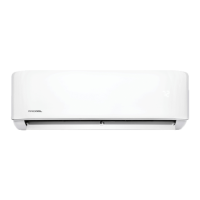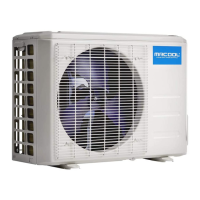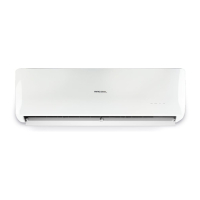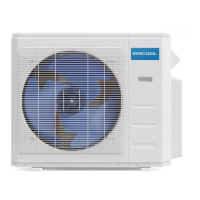Page 13
CAUTION
Be extremely careful not to dent or damage the piping while bending them away from the unit.
Any dents in the piping will affect the unit’s performance.
Step 4: Prepare refrigerant piping
The refrigerant piping is inside an insulating
sleeve attached to the back of the unit. You
must prepare the piping before passing it
through the hole in the wall. Refer to the
Refrigerant Piping Connection section of
this manual for detailed instructions on pipe
1. Based on the position of the wall hole
relative to the mounting plate, choose the
side from which the piping will exit the unit.
2. If the wall hole is behind the unit, keep the
knock-out panel in place. If the wall hole is
to the side of the indoor unit, remove the
plastic knock-out panel from that side of
the unit. (See Fig. 3.3 ). This will create a
slot through which your piping can exit the
unit. Use needle nose pliers if the plastic
panel is too difficult remove by hand.
Knock-out Panel
Use scissors to cut down the length of the
insulating sleeve to reveal about 6in (15cm) of
the refrigerant piping. This serves two
purposes:
• To facilitate the Refrigerant Piping
Connection process
• To facilitate Gas Leak Checks and enable
you to check for dents
If existing connective piping is already
embedded in the wall, proceed directly to the
Connect Drain Hose step. If there is no
embedded piping, connect the indoor unit’s
refrigerant piping to the connective piping that
will join the indoor and outdoor units. Refer to
the Refrigerant Piping Connection section
of this manual for detailed instructions.
Based on the position of the wall hole relative
to the mounting plate, determine the
necessary angle of your piping.
Grip the refrigerant piping at the base of the
bend.
Slowly, with even pressure, bend the piping
towards the hole. Do not dent or damage the
piping during the process.
NOTE ON PIPING ANGLE
Refrigerant piping can exit the indoor unit from
four different angles:
• Left-hand side
• Left rear
• Right-hand side
• Right rear
Refer to Fig. 3.4 for details.
Fig. 3.3
Fig. 3.4
Indoor Unit Installation

